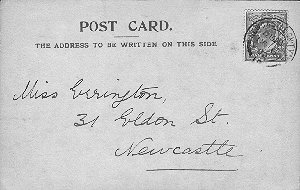
 |
|
The Birth of the Postcard. A Condensed History The first plain postcard appeared about 1869 in Austria. The address
only, being allowed on the back with the message written the front. By
the mid 1870's the first picture postcards had made their appearance in
Germany. Being artist drawn cards.
In 1894, on the first Picture Postcards, by law one side was still reserved for the address. The picture had to share the front with a small area left blank for the message. This was still enough to capture the public's imagination. In 1898 with the size of 4.75ins x 3.5 ins, already in use in other countries, was accepted as the standard in Britain. Added to this The halfpenny posting price,The scene was set for an expodental increase in postcard sales. Also, during the Paris Exhibition of 1889 postcards received a big boost in popularity and helped them become the favourite means of sending messages in Europe. 1898 saw the first photographs on the front of Postcards and by 1900 Music Hall and Theatres found the postcard as a useful advertising medium for their shows. More shrewdly perhaps, performers actors and actresses found that they could augment their income by posing for portraits that could be sold as Postcards. They became the first ‘pin ups'. The more successful artistes often had exclusive contracts with Postcard companies. These Postcards still by law had to have the address only on the back and a small area was being left for a brief message (Ex 1) (Ex 2)
In 1902 the Post Office changed its rules and allowed pictures to appear on the front of postcards and message and address both to appear on the back. From around September 1902 onwards, postcard manufacturers began to issue cards with a line drawn down the middle of the back to show where the message and address should be written..These cards soon replaced the earlier ones with undivided backs..This led to a huge increase in postcard production and quality.
The years from 1902 - 1914 have often been called the 'Golden Age' of Picture Postcards because people from all walks of life, rich and poor alike, sent postcards for a variety of reasons in a variety of forms. With the more widespread use and cheaper costs of contemporary photography, many ordinary people would sit for a portrait, and have several portraits developed in ‘court size' with divided backs to be used as postcards. These could be sent to family, sweethearts ect for the price of a halfpenny. This was the cheapest and most reliable form of mass communication of
the day. There were seven posts each day and it was possible to send a
postcard in the morning and receive an answer back in the afternoon! For reasons of quality and price, most cards used in the UK were printed in Germany, but the First World War brought that to a close.After 1918 the postal rate doubled to one penny. Many sources have given this as the reason for the decline in Postcard usage, but the telephone became more widespread in the post Great War years helping the decline of postcards and putting an end to the 'Golden Age' of postcards. This is not to say that the postcard became ‘out of date'. The role of the postcard changed becoming increasingly associated with seaside holidays including the slightly risque postcards that can to this day be found in modern holiday resorts. Although they are a far more ‘adult' affair than their predecessors. |
Example 1
|
|
 |
||
|
Ex 2
|
||
 |
||
|
The message reads; " You can send me Chas Wyndham
or Queen Alexandra. I saw "Sappho" on Tuesday night. Love from
Shiela L" (?) Olga Nethersole starred in the play.
|
||
|
Ex 2b: undivided back of above card.
|
||
 |
||